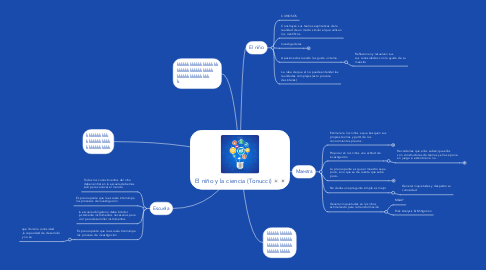
1. kkkkkkkkkkkkkkkkkkk kkkkkkkkkkkkkkkkk kkkkkkkkkkkkkkk k
2. Escuela
2.1. Todos los conocimientos del niño deben entrar en la escuela debemos salir para conocer el mundo.
2.2. Es preocupante que la escuela interrumpa los procesos de investigacion
2.3. la escuela obligatoria debe brindar justamente instrumentos necesarios para vivir para desarrollar instrumentos
2.4. Es preocupante que la escuela interrumpa los proceso de investigación
2.4.1. que limite la curiosidad ,la capacidad de desarrollo y no se
3. kkkkkkkkkk kkkkkkkkkkk kkkkkkkkkkk
4. El niño
4.1. CURIOSOS
4.2. Construyen sus teorías explicativas de la realidad de un modo similar al que utilizan los científicos.
4.3. Investigadores
4.3.1. kkkkkkkkkk
4.4. Apasionados cuando les gusta un tema .
4.4.1. Reflexionan y resuelven sus sus curiosidades con la ayuda de su maestro
4.5. La idea de que el no puede entender las realidades complejas (esto provoca desinterés)
5. Maestra
5.1. Estimular a los niños a que busquen sus propias teorías y partir de los conocimientos previos .
5.1.1. Situational Analysis / Drivers
5.1.1.1. What is driving us to do this?
5.1.1.2. SWOT Analysis
5.1.1.2.1. Strengths
5.1.1.2.2. Weaknesses
5.1.1.2.3. Opportunities
5.1.1.2.4. Threats
5.1.1.3. Customer Findings - What have we learned from customers?
5.1.2. Competitive Analysis
5.1.2.1. Do we have competitors and threats in these target markets with the proposed offerings?
5.1.2.2. What are our competitors doing and how are they positioning?
5.1.2.3. How do we position against each competitor?
5.1.3. Target Customer(s)
5.1.3.1. Buyer Profile
5.1.3.1.1. Title
5.1.3.1.2. Industry
5.1.3.1.3. Geography
5.1.3.1.4. Business Size
5.1.3.2. Influencer Profile
5.1.3.3. User Profile
5.1.3.4. What do customers want and need?
5.1.3.5. What business problems do each of these customers have?
5.1.4. Customer Segmentation
5.1.4.1. Which customers or sets of customers do we sell to?
5.1.4.2. What are the target market segments that we want to go after?
5.1.4.3. What are the distinct problems for each segment of the market?
5.1.5. Total Available Market
5.1.5.1. New Prospects
5.1.5.1.1. How much of each target segment have we penetrated?
5.1.5.1.2. How much opportunity is available in each target segment?
5.1.5.2. Existing Customers
5.1.5.2.1. Can we up-sell existing customers?
5.2. Propiciar en los niños una actitud de investigación
5.2.1. Recordarles que ellos saben;que ellos son constructores de teorías y ella se pone en juego si están bien o no .
5.2.1.1. What is the Value Proposition to the Customer?
5.2.1.2. What pain are we solving?
5.3. Lo preocupante es que el maestro sepa poco, sino que se de cuenta que sabe poco-
5.3.1. Positioning & Messaging
5.3.1.1. What is the key messaging and positioning for the service offer? (Pain, alternatives, solution)
5.3.1.2. How do we communicate internally?
5.3.1.3. How do we communicate externally?
5.3.2. Promotion Strategy
5.3.2.1. Marketing Programs (Installed base versus new prospects)
5.3.2.2. Advertising (Publications, etc.)
5.3.2.3. Analyst Relations (Target Analysts)
5.3.2.4. Public Relations
5.3.2.5. Events (Trade shows, SEO/SEA, Seminars)
5.3.2.6. Webinars
5.3.3. Demand Generation & Lead Qualification
5.3.3.1. How do we generate and qualify new leads for the target offer?
5.3.3.2. Prospect Lists
5.3.3.3. Key Questions to Ask
5.3.3.4. Sales Collateral
5.3.3.5. Presentations
5.3.3.6. Data Sheets
5.3.3.7. White Papers
5.3.3.8. ROI Tools
5.3.3.9. Other Sales Tools (web site, etc.)
5.4. No darles una pregunta simple es mejor
5.4.1. Generar inquietudes y despertar su curiosidad
5.5. Generan inquietudes en los niños estimulando para la transformación
5.5.1. M&A?
5.5.2. Risk Analysis & Mitigation

